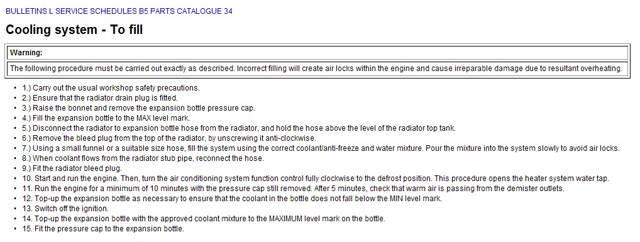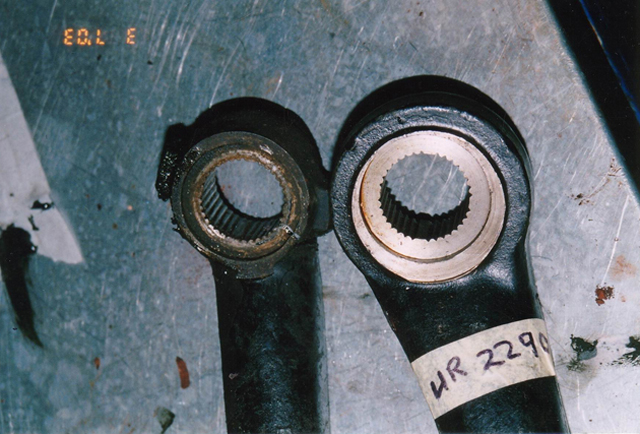| Author | Message | |||
David Gore Moderator Username: david_gore Post Number: 1212 Registered: 4-2003 |
The following test uses images supplied by Brian Vogel which have been resized to the allowable sizes for this forum:     Brian, the images you supplied were, in my opinion, standard 150dpi photocopier scans [typical file size 60/150KB] and are marginal as they do not have fine enough detail for good reproduction. In my experience, scans need to be 300dpi or better for good reproduction in 640 x 480 pixels. The following photograph of a cracked Shadow Pitman arm and its replacement was scanned from a standard photo print at 300dpi and has been resized to 640 x 480 high quality using Photoshop:  | |||
Richard Treacy Grand Master Username: richard_treacy Post Number: 2772 Registered: 4-2003 |
Best simply post the PDF in the first place and be done with the messing around. Smaller, clearer and easier. Just click on the icon to open it, to view it or to save it. RT.
| |||
Richard Treacy Grand Master Username: richard_treacy Post Number: 2774 Registered: 4-2003 |
Posting a PDF is especially ideal when the original or its inherent extract is a PDF in the first place. That applies to most documents in the Technical Library and to all TSD5000/6000-series IETIS/MTVIEW/ASSISTA SZ documents. In case of multiple pages, usually without loss of quality you may always compress a PDF very easily to reduce its size if the 100kB limit is reached whilst still posting those multiple pages in a single file. Incidentally, and not really on the core of this post, the procedure for filling most SZ cars, as shown in the above PDF, misses a vital step. Before filling, lift the LHS front of the vehicle to tilt its front bumper at 15 degrees. That helps the bleeding process enormously !! Many of these cars run for a few weeks dumping coolant after a refill even when the book procedure is observer to the letter until all the last bubbles self-bleed, but the tilt method never fails to make the job quick and sure. Many bemused mechanics miss this point. RT. | |||
Brian Vogel Prolific User Username: guyslp Post Number: 246 Registered: 6-2009 |
Richard, What PDFs does IETIS extract from? I can create PDFs from IETIS by printing through PDF Creator, but there are no native PDF files under the IETIS folders that I can find using a Windows search. The problem (if one can call it that) still remains with the strict 640x480 pixel picture size limit, but that can be worked around when necessary with larger pictures. Brian | |||
David Gore Moderator Username: david_gore Post Number: 1213 Registered: 4-2003 |
Brian, One of the reasons for the 640 pixel width restriction is to ensure the image will appear in its entirety on all monitor screens. Wider images have the down-side that sideways scrolling becomes tiresome if the wider image is too large for the monitor screen. The entire thread is affected not just the post with the wide picture. Richard's comment about including PDF files as attachments is noted but my experience has been my PDF files have exceeded the limit even after reducing the file size by quality reduction of the contents and using the compression tool in Acrobat after compilation. David - whose life is one challenge after another....... | |||
Jonas TRACHSEL Experienced User Username: jonas_trachsel Post Number: 31 Registered: 2-2005 |
Recently I have come across the abbreviation "IETIS" in several threads. My ignorance prevents me to understand the meaning of this expression and hence the whole contribution usually makes no sense to me. Can anybody explain what IETIS is? Jonas | |||
Brian Vogel Prolific User Username: guyslp Post Number: 249 Registered: 6-2009 |
Jonas, I never knew what the IETIS acronym meant until I looked it up in response to your query: Integrated Electronic Technical Information System. From the 1990 model year forward, there were no Workshop Manuals, Illustrated Parts Manuals, etc., printed. This information was instead bundled into a software package: IETIS. So, it now makes sense to refer to the source of information for cars after 1990 as coming from IETIS. Brian, who notes you'll also see references to TSD6000 which, as far as I know, is the same thing as IETIS (at least for the 1990-2000 model years, I don't know what the TSD number is for IETIS for the Seraph/Arnage period) | |||
Jan Forrest Grand Master Username: got_one Post Number: 450 Registered: 1-2008 |
I found to my cost the reason for not using strong alkaline concentrations some years ago when trying to clean out the blockages in the engine of my then Reliant Scimitar GTE. Although the block was iron, the radiator overflow wasn't and it almost completely dissolved away. I've since discovered the advantages of true organic acids - in particular Citric. When used in concentrations up to 500 grams of crystals per gallon it will not attack most pure metals, but is strongly effective against metal salts although the cheaper chrome (usually nickel) plating can be completely stripped from the surface of the plated article at high temperatures. There are You Tube postings about using it to strip rust from iron/steel components as well as the use of molasses and water; the latter I have yet to try out. I've used citric acid to good effect in both of my Toyota Estimas which are very sensitive to coolant condition and will often exhibit terminal cracks in the cylinder heads at relatively low mileages - often not much over 100K. Our semi house trained Estima Club expert mechanic (and revered chairman - fuel consumption 2 bacon butties and 5 mugs of char per hour) has maintained several of the marque for some years which have been used as taxis and which can now boast over 400K 'under the belt' on the original heads! Legal Note: The usual 'at your own risk' conditions apply to this recommendation. |